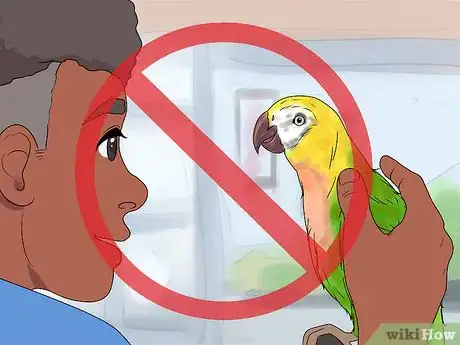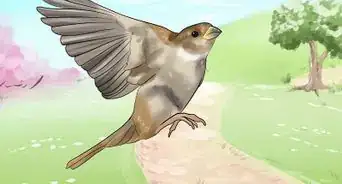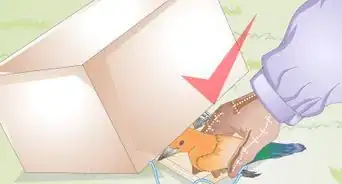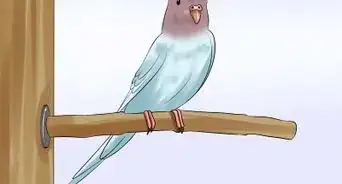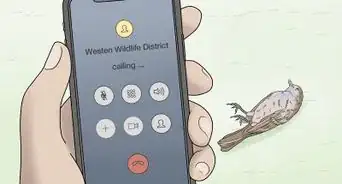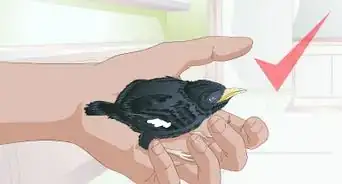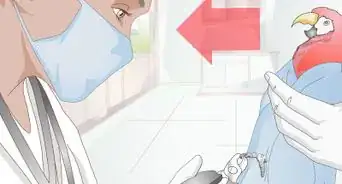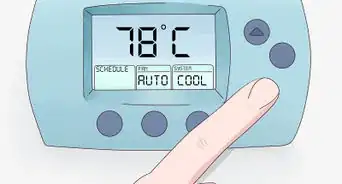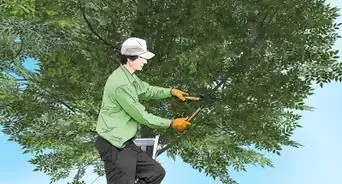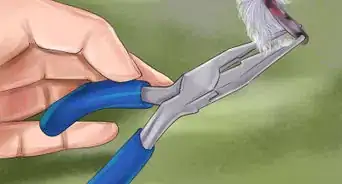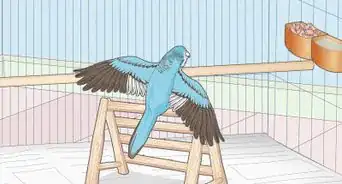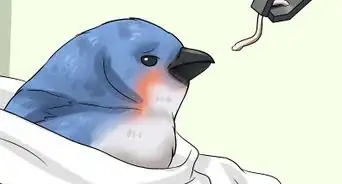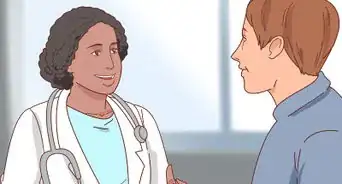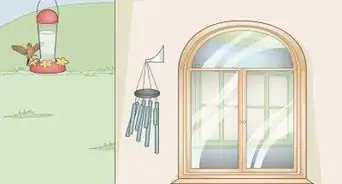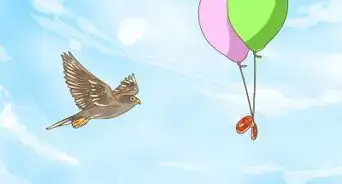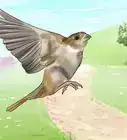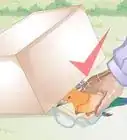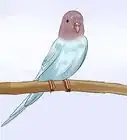This article was co-authored by Hayley Heartfield. Hayley Heartfield is a Bird Specialist and the Owner of About Birds, a Pet Bird Shop in Montgomery County, Texas. Hayley specializes in pet bird care, behavior, training, and breeding. Hayley studied Animal Science at Texas A&M. About Birds carries many species of birds and offers grooming and boarding services as well as bird care products.
There are 8 references cited in this article, which can be found at the bottom of the page.
wikiHow marks an article as reader-approved once it receives enough positive feedback. In this case, 96% of readers who voted found the article helpful, earning it our reader-approved status.
This article has been viewed 119,907 times.
Molting is a parrot’s natural shedding process; it takes about 2 months for them to lose their old feathers and grow new ones. Typically, parrots undergo this process once or twice a year. During this time, parrots will develop pin-like growths, known as pin feathers, from the follicles in their skin. This is often uncomfortable and itchy for your parrot, so it’s important that you make your pet as comfortable as possible.
Steps
Making Your Parrot More Comfortable
-
1Mist your parrot 2 times per day to make it feel comfortable. Misting your bird will provide extra humidity to the bird’s cage, which will make it less itchy. Use a mister or spray bottle to mist your bird with room-temperature water.[1]
- Misting regularly will also soften the hard sheath that forms around the pin feathers, which will make them easier to remove once the new feathers have grown in.
- Misting or spraying your bird replicates rainfall for the bird. You should do this 2-3 times a week even when your bird isn’t molting.
- You can also buy soothing bird bath sprays with aloe to help soothe the bird.[2]
-
2Let your parrot rest more than usual. Your parrot may be grumpy or exhibit a twitching behavior while it's molting because it’s itchy and uncomfortable. Do not disturb the bird while it’s sleeping or resting. Place the bird in a dark area where it won't be disturbed for 12-13 hours per day during the molting process. Be patient with your bird and let it get all the rest it needs.[3]
- Adequate sleep is important for the new feathers' development.
Advertisement -
3Avoid petting the bird while the pin feathers are coming in. Pin feathers are filled with blood and are very sensitive when they first start growing in. Petting your bird vigorously could damage them and hurt your bird, so avoid doing it.[4]
- Once the feathers grow in and the hard sheath around the base of the feather flakes off, you can start petting your bird again without hurting it. This will occur towards the end of the molting process.
-
4Keep your parrot in a space that's room-temperature. As your parrot's feathers fall out, it will be more susceptible to chilly drafts. Because of this, make sure that the room you're keeping your bird in is room temperature, or generally 70 °F (21 °C). Keep them away from windows or open doors if it's cold outside.[5]
- Even though parrots are tropical birds, making the room too hot while they molt may cause them additional discomfort.
Tending to Your Bird
-
1Roll your finger along the parrot's head and neck once the feathers grow. The parrot will naturally remove or shed its old feathers, but some may still remain on spots that it can’t reach, like its head and neck. Wait for the feathers to grow in and for the hard sheath around the base of the feather to start to flake. When this occurs, lightly roll your finger along the head and neck of your parrot to remove the flaky sheath.[6]
- If the sheath is still hard and waxy, it’s not ready to come out.
- If the parrot has a partner, the partner will usually remove old feathers on the parrot’s head and neck. However, if it doesn’t, you’ll have to do it.
- Loose feathers and flakes may fall out as you do this.
- It’s important to wait until the feathers are developed or you’ll hurt your bird.
-
2Feed your parrot a slice of cucumber and extra protein daily. As your parrot grows new feathers, it requires more nutrients. Feeding the parrot a slice of fresh cucumber will provide an extra source of nutrients other than its main food. Increase the amount of protein your bird eats by giving it egg food for parrots or hard-boiled egg yolks daily. This will help the bird grow strong and healthy feathers.[7]
- Wash the cucumber thoroughly before feeding it to the bird to remove any harmful pesticides.
- Don't feed your parrot more than a single slice of an averagely sized cucumber per day or you may overfeed it.
- Remove any fresh food from the bird’s cage daily so that it doesn’t get moldy.
-
3Take your parrot to a vet if it molts more than twice a year. If a bird molts more than twice a year, it means that it’s not eating the proper diet or its light cycle is off. Make sure that you’re feeding your parrot enough food and nutrients while it molts. In addition, most parrots should receive 10-12 hours of sunlight and 10-12 hours of darkness a day. If you’re caring for your bird properly and it’s still molting more than twice a year, it could be a sign of stress or a more serious medical condition and you should take your parrot to the vet as soon as possible.[8]
- If your bird is not getting enough sunlight or the right nutrients, it could alter the molting schedule and how often the bird molts.
- Parrots molt at different times depending on the species, but typically it occurs in the fall after mating season.
- You can replace natural sunlight with UV-B light bulbs.
-
4Take your bird to the vet if a pin feather starts bleeding. Pin feathers are filled with blood and don’t clot when they are damaged. This could cause your parrot to bleed out if one of its pin feathers is damaged or broken. If you notice this, the feather must be removed from the follicle by a trained avian veterinarian. If you don’t, there's a chance that your bird could die.[9]
- Once you take your bird home, let it rest as much as it needs. The vet should have stopped the bleeding and the new feather will grow in.
Expert Q&A
-
QuestionHow can I help my parrot molt?
 Hayley HeartfieldHayley Heartfield is a Bird Specialist and the Owner of About Birds, a Pet Bird Shop in Montgomery County, Texas. Hayley specializes in pet bird care, behavior, training, and breeding. Hayley studied Animal Science at Texas A&M. About Birds carries many species of birds and offers grooming and boarding services as well as bird care products.
Hayley HeartfieldHayley Heartfield is a Bird Specialist and the Owner of About Birds, a Pet Bird Shop in Montgomery County, Texas. Hayley specializes in pet bird care, behavior, training, and breeding. Hayley studied Animal Science at Texas A&M. About Birds carries many species of birds and offers grooming and boarding services as well as bird care products.
Bird Specialist Try giving your bird a weekly bath as it molts. Bird bath sprays made with aloe may help your bird.
Try giving your bird a weekly bath as it molts. Bird bath sprays made with aloe may help your bird. -
QuestionHow do I tell if the bird is molting?
 Community AnswerIf a bird is molting, it will have a lot of pin feathers around its head area, and it will look ragged, with a bunch of dropped feathers at the bottom of the cage.
Community AnswerIf a bird is molting, it will have a lot of pin feathers around its head area, and it will look ragged, with a bunch of dropped feathers at the bottom of the cage. -
QuestionWhat should I do if my parakeet has bare patches of skin?
 Community AnswerTake it to a vet, this isn’t normal for a molting bird. During a regular molt, the bird should not lose all its feathers at the same time. Bare patches could mean the bird is plucking.
Community AnswerTake it to a vet, this isn’t normal for a molting bird. During a regular molt, the bird should not lose all its feathers at the same time. Bare patches could mean the bird is plucking.
Warnings
- If your parrot's feathers start to grow in abnormally, don't grow in at all, or you notice bumps on the parrot's skin, take it to an avian vet as soon as possible. This is a sign that there is something wrong with the bird.⧼thumbs_response⧽
References
- ↑ https://youtu.be/r4LQkiNxptc?t=172
- ↑ Hayley Heartfield. Bird Specialist. Expert Interview. 23 June 2021.
- ↑ https://blog.nature.org/science/2015/09/28/angry-birds-molting-grumpy-science/
- ↑ https://youtu.be/r4LQkiNxptc?t=185
- ↑ https://www.2ndchance.info/molt.htm
- ↑ https://www.2ndchance.info/molt.htm
- ↑ https://youtu.be/vWuS3657xv4?t=27
- ↑ https://www.allaboutbirds.org/the-basics-feather-molt/
- ↑ https://youtu.be/r4LQkiNxptc?t=193
About This Article
To care for a molting parrot, mist the bird twice per day with room temperature water to ease discomfort and itchiness. Allow your parrot to rest more than usual, since adequate sleep is important for the development of new feathers. Feed your bird a fresh cucumber slice every day to provide essential nutrients that can help the process along. Once the pin feathers start coming in, avoid petting the bird because its skin will be very sensitive. For tips on what to do if you notice a bleeding pin feather, read on!



